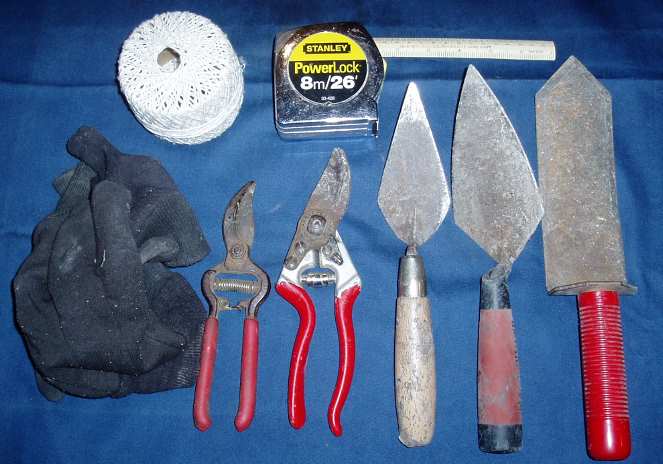 The best part about doing more careful excavation is the simple tool kit
--- not too hard on the back!
The best part about doing more careful excavation is the simple tool kit
--- not too hard on the back!
You need the following to have the minimal toolkit (some not shown above):
string and nails to mark out the unit you will dig;
gloves (best to have several pair of different thickness);
a metric ruler of some sort--- the PowerLock above has both
metric and feet -- this will help you get used to the metric system, which
is standard for this work... (don't freak out about it though--- good measurements
in any system will work!);
trowels.... a good trowel will cost you little and last a long
time--- let's look closer at one above....
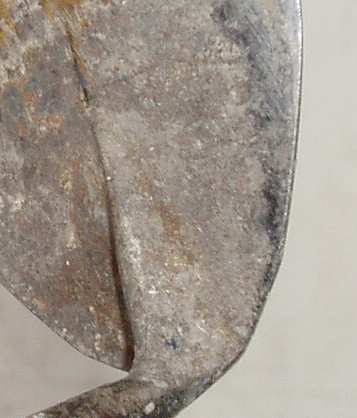
Look for a trowel with a one-piece forged handle--- this
one won't fall apart over time!
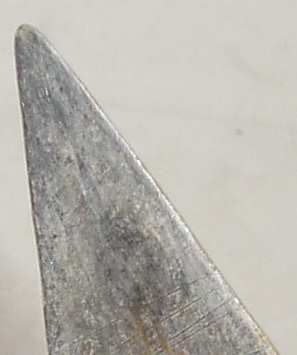
The savvy trowel-user will bevel the edge of the trowel to get the
dirt to shave away!
Now, some folks only bevel one edge of their trowel, but I like to
do both edges and change hands!
Amazing how well a trowel moves soil... and you miss nothing!
Good trowels are easy to find. For a great lightweight trowel that all
the pros use, buy a Marshalltown Trowel-- they sell at most of the better
chain stores for about $8.
The heavyweight trowel shown on the right above is great for starting
pits, and other harder to dig areas and sells for about $30. It is made
by Paul Leslie and can be ordered from his website: www.texastreasurehunting.com
Line Level.... you need this, well to pull a level line from
which to measure depth. All depths are measured from the datum point's
elevation reading. You can take the "real" reading, then set it to 100
and measure from there... you tie a piece of string to the datum point,
pull it across the pit, leveling it, then dropping the ruler from
it, measuring the depth of your find (relative to the datum point standard)!
Line levels are cheap (about $1.50) and available at any hardware store;
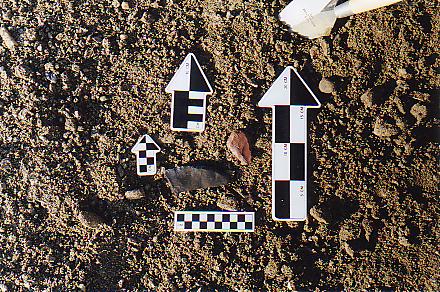
metric rulers.... the classic ones with black and white blocks are
available at Stoney Knoll Archaeological
Supplies... $1.00- 3.00 each;
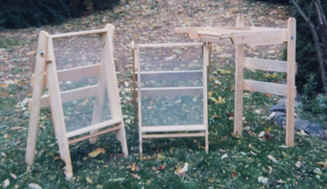
Sifter... I bought mine from Stoney
Knoll Archaeological Supplies, a small family-owned company. From
$80+, you can get a sifter to fit your needs.... they even make one you
can tote on your back!
GPS.... A GPS is a piece of tech that has only recently become
affordable to nearly everyone. They can be bought for as little as $100
and a cheap one works as well as most of the higher priced consumer models.
I bought one not really made for the outdoors, but useful for everyday
life as well as in the field. I purchased the $500 Garmin iq3600. I keep
it in a $15 waterproof Pelican box. I love the darn thing and won't be
caught without it! Here's a picture of it:
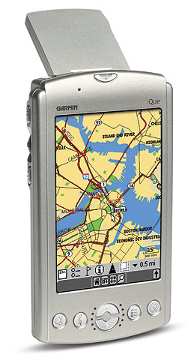 Get a GPS, and you can store the location of everything you ever find!
I store topo maps on mine and can switch back and forth to flat maps, or
use them as an overlay. Best part of this system is the fact that you can
store notes linked to the location, as well as record voice notes taken
while walking a site. I understand that Garmin has lowered the price of
this model and is now offering a more rugged version of the iq3600.
Get a GPS, and you can store the location of everything you ever find!
I store topo maps on mine and can switch back and forth to flat maps, or
use them as an overlay. Best part of this system is the fact that you can
store notes linked to the location, as well as record voice notes taken
while walking a site. I understand that Garmin has lowered the price of
this model and is now offering a more rugged version of the iq3600.
Remember that the topo maps cost extra, usually around $100, and you'll
need more storage for the maps, that chip will cost another $100.
Other tools you'll need, or want, on site:
Floor broom & whisk broom, or set of paintbrushes...
c'mon, you've seen this on TV... when you find something, you brush the
soil away, gently now;
sifter... with different gauges of screen, if possible, but
1/4" grid works pretty well overall;
dustpan... to sweep up the dirt into the....
buckets.... to carry the dirt to the sifter....
shovel.... sure, you might need one!
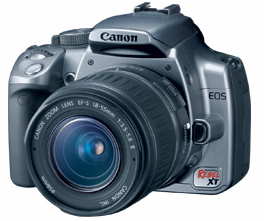
camera... you'll want to take one with you to record the site, as
done in this report! I've used all kinds of cameras, eventually buying
a CANON EOS Rebel XL ($995), but any camera, in the right hands, will work.
For years, I used inexpensive Olympus digital cameras on the Dirt Brothers
website--- they've got a 5 megapixel camera available now for under $300,
a very good buy! I find digital cameras are the better choice because you
can check to make sure the picture is exposed properly right away.
All packed up, we're ready to dig! |




